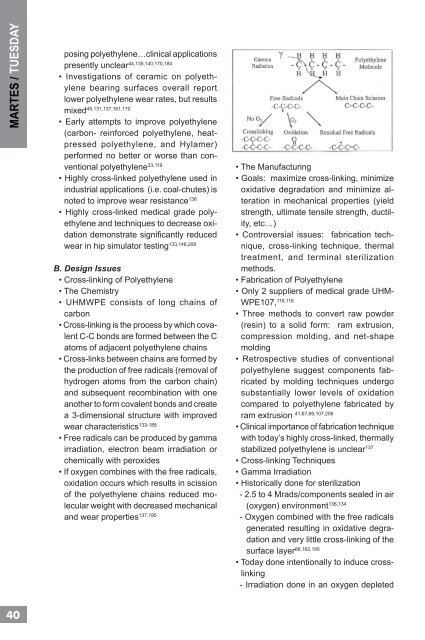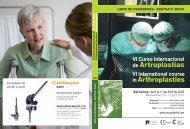cadera / hip - Active Congress.......
cadera / hip - Active Congress.......
cadera / hip - Active Congress.......
Create successful ePaper yourself
Turn your PDF publications into a flip-book with our unique Google optimized e-Paper software.
MARTES / TUESDAY<br />
40<br />
posing polyethylene…clinical applications<br />
presently unclear 44,135,140,170,184<br />
• Investigations of ceramic on polyethylene<br />
bearing surfaces overall report<br />
lower polyethylene wear rates, but results<br />
mixed 45,131,137,161,170<br />
• Early attempts to improve polyethylene<br />
(carbon- reinforced polyethylene, heatpressed<br />
polyethylene, and Hylamer)<br />
performed no better or worse than conventional<br />
polyethylene 33,119<br />
• Highly cross-linked polyethylene used in<br />
industrial applications (i.e. coal-chutes) is<br />
noted to improve wear resistance 136<br />
• Highly cross-linked medical grade polyethylene<br />
and techniques to decrease oxidation<br />
demonstrate signifi cantly reduced<br />
wear in <strong>hip</strong> simulator testing 133,146,209<br />
B. Design Issues<br />
• Cross-linking of Polyethylene<br />
• The Chemistry<br />
• UHMWPE consists of long chains of<br />
carbon<br />
• Cross-linking is the process by which covalent<br />
C-C bonds are formed between the C<br />
atoms of adjacent polyethylene chains<br />
• Cross-links between chains are formed by<br />
the production of free radicals (removal of<br />
hydrogen atoms from the carbon chain)<br />
and subsequent recombination with one<br />
another to form covalent bonds and create<br />
a 3-dimensional structure with improved<br />
wear characteristics 133-185<br />
• Free radicals can be produced by gamma<br />
irradiation, electron beam irradiation or<br />
chemically with peroxides<br />
• If oxygen combines with the free radicals,<br />
oxidation occurs which results in scission<br />
of the polyethylene chains reduced molecular<br />
weight with decreased mechanical<br />
and wear properties 137,195<br />
• The Manufacturing<br />
• Goals: maximize cross-linking, minimize<br />
oxidative degradation and minimize alteration<br />
in mechanical properties (yield<br />
strength, ultimate tensile strength, ductility,<br />
etc…)<br />
• Controversial issues: fabrication technique,<br />
cross-linking technique, thermal<br />
treatment, and terminal sterilization<br />
methods.<br />
• Fabrication of Polyethylene<br />
• Only 2 suppliers of medical grade UHM-<br />
WPE107, 116,118<br />
• Three methods to convert raw powder<br />
(resin) to a solid form: ram extrusion,<br />
compression molding, and net-shape<br />
molding<br />
• Retrospective studies of conventional<br />
polyethylene suggest components fabricated<br />
by molding techniques undergo<br />
substantially lower levels of oxidation<br />
compared to polyethylene fabricated by<br />
ram extrusion 41,67,69,107,206<br />
• Clinical importance of fabrication technique<br />
with today’s highly cross-linked, thermally<br />
stabilized polyethylene is unclear 137<br />
• Cross-linking Techniques<br />
• Gamma Irradiation<br />
• Historically done for sterilization<br />
- 2.5 to 4 Mrads/components sealed in air<br />
(oxygen) environment 136,134<br />
- Oxygen combined with the free radicals<br />
generated resulting in oxidative degradation<br />
and very little cross-linking of the<br />
surface layer 66,162,195<br />
• Today done intentionally to induce crosslinking<br />
- Irradiation done in an oxygen depleted





